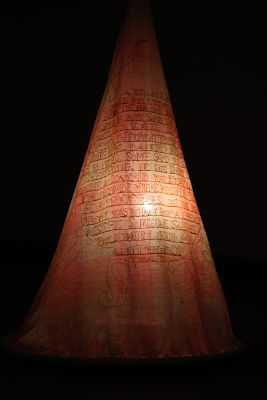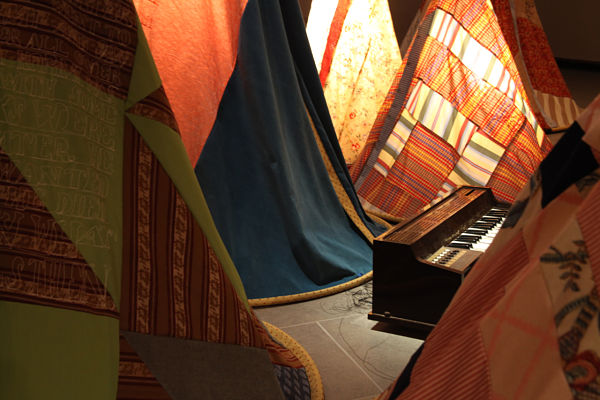An air of mystery emanates from The Deathworks of May Elizabeth Kramner--from outside the gallery the drone of organs is reminiscent of an overheard church service.
Inside the room is dim, darkened by walls painted black--an arrangement of illuminated, quilted tents flicker on and off again like the communicants in a rite. Harmoniums placed throughout click percussively as the keys respond to a logarithm that controls both their chords and the lights. The unpredictability of the sequence gives the installation a certain liveliness like a field of fireflies or the din of distant conversation. Indeed, to the extent that the work relates to death, this is not a static commemoration so much as it seems a communion of some sort.
The installation, now at the Maryland Institute College of Art through November 18th, is the work of the Poyais Group, whose members consist of writers Jesse Ball and Thordis Bjornsdottir, visual/installation artist Olivia Robinson and musician/new media artist Jesse Stiles.

A short text at the entrance informs us it is a re-creation of the life-work of one May Elizabeth Kramner (1867-1977), an outsider artist whose work "consisted of a model of the town in which she lived" where "each house was represented by a tent and on each tent was sewn the manner of death of a person (or persons)" who lived there.
Around forty in number, and ranging in size from two to eight feet high, the tents are gathered in clusters like people at a party. Pink and blue and striped, they are not an intimidating group, and yet the intricacy of their craft suggests they've worn their finery. The bright colors, the rustic quality of the twine that suspends them from the ceiling, the large block letters embroidered over their surfaces have a comfortingly hand-made aesthetic. And though certainly not morose, they do elicit the slightly haunted feel of older things.

The music is also inviting. The warm, breathy sound of the harmoniums plays at random, and yet it seems as though a melody were about to emerge. The constant evolution of the pattern recalls the varying monotony of waves, both restful and absorbing. Just like the ocean, it is an atmosphere alternately lulling and disquieting.
And yet, though seemingly straightforward, there is something disorienting in the approach to this piece. As the work of an imaginary character, the installation might have felt somewhat quaint, but instead the narrative distance complicates it. These are not the artifacts of Ms. Kramner's work, we are told, but rather objects inspired by them. And so, though presented with one set of tents, in a sense the viewer interacts with a second, phantom set. The physical tents are considered in light of what we imagine about the originals. They stand in for the ideas we entertain about Ms. Kramner, such as her strange relationship to memorial, and the life that inspired it. Though newly made, we imagine instead the resonance of objects painstakingly created over a lifetime.
People familiar with the novels of Jesse Ball (The Curfew, The Way Through Doors, Samedi the Deafness), who frequently posits stories within stories, may recognize the sleight of hand that couches this installation within its context. Never asked to believe in the origins of the project, but rather only in the origins of its inspiration, the framework suspends questions about Ms. Kramner's existence, even as it makes her person resonate all the more throughout the piece.

Many artists use narratives, but the fictional device is often meant to be seen through. When Sophie Calle has herself followed by a private investigator, or creates artwork as a character invented by Paul Auster, the story is her point of departure, not the viewer's. For Calle, fiction is the context for examining certain themes, but the result is the experience of inhabiting that invention, not a story as such. When we look at the elaborately staged scenes in a Gregory Crewdson photograph, we may experience a heightened sense of reality, and yet we never approach it as documentary. Or again, when Dennis Cooper and Gisèle Vienne dramatize the crimes of a teenage serial killer, fiction is only a medium of the work, not the focus of it.
In contrast, The Deathworks doesn't distinguish fiction from reality. (The only clue comes from the group's name--Poyais--an obscure reference to a fictional Central American country.) Here narrative creates both the context for the work and drives the way we interact with it. By engaging the viewer's imagination he/she becomes an active participant in the story's creation, and in doing so the installation reveals that the way we understand any character--fictional or historical--is actually quite similar. We construct ideas and arrive at conclusions based on the evidence of a few plausible facts. We draw meaning from connections made to our own experience. And we bring our own vision to the places and faces and objects described to us. The power of any one story is not just in whether it happened or not, but what we derive from considering it. In some ways the longing for a fictional character is not much different than a longing for the dead.
All photos courtesy the Poyais Group.